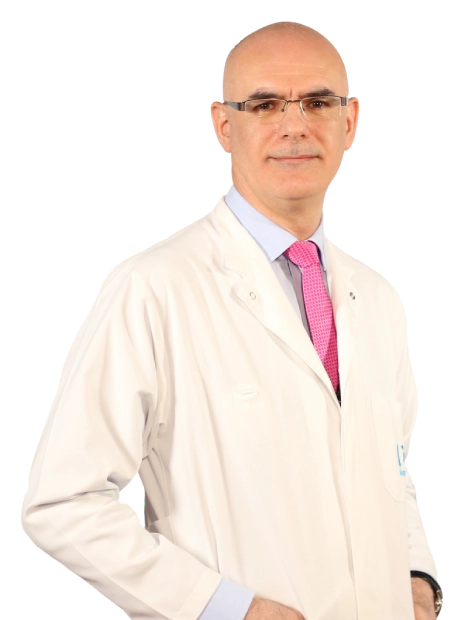What is Testicular Cancer?
The testicles are a crucial part of the male reproductive system and are responsible for the production of testosterone and sperm. However, Testicular Cancer can develop in the testicles for various reasons. Although this condition is rare, it can lead to more serious health problems if not detected and treated early.

Testicular Cancer
The testicles are part of the male reproductive system, where sperm and the male sex hormone testosterone are produced. Located in sacs called the scrotum, the testicles play a key role in fertility and hormone regulation. Testicular cancer occurs when abnormal cell growth develops in the tissue of the testicles.
Biology and Types of Testicular Cancer
Testicular cancer develops when irregularities in the cellular structure of the testicles lead to uncontrolled cell growth and division. There are two main types of testicular cancer: seminoma and nonseminoma. Their biological characteristics can be explained as follows:
- Seminoma is a type of testicular cancer that starts in the germ cells. It typically grows slowly and has a lower risk of spreading compared to other types. Seminoma tumors usually have well-defined borders and result from the abnormal growth of germ cells within the testicles.
- Nonseminoma cancers are a group of testicular cancers that can originate from a variety of different cell types within the testicle. They typically grow more rapidly than seminomas and have a higher potential to spread to other tissues. Nonseminoma tumors may involve abnormal growths arising from multiple cell types in the testicles.
Causes and Risk Factors for Testicular Cancer
This cancer type can develop due to a combination of causes and risk factors. These include genetic, environmental, and lifestyle influences, described below:
Genetic Factors and Testicular Cancer
Genetic factors play a significant role in the development of testicular cancer. Having a family history of testicular cancer increases a person's risk, and it may also mean that other family members are at higher risk as well.
Random gene mutations can also affect the risk of testicular cancer. Changes or mutations in genes can affect normal cell growth and division processes. This can lead to abnormal cell growth and cancer development in testicular tissue. Some genetic conditions, such as Klinefelter syndrome, can also increase the risk of testicular cancer. This syndrome is caused by abnormalities in the X and Y chromosomes and can affect the normal development of the testicles.
Genetic counseling is valuable for people at increased risk of testicular cancer. It involves assessing cancer risk through genetic testing and reviewing family history. If you have a high risk due to family history or genetic factors, regular medical check-ups and following your doctor's advice can help with early detection and effective treatment.

Environmental Factors and Testicular Cancer
Environmental factors can also influence the development of testicular cancer. These may include:
- Chemical Exposure: Exposure to substances like pesticides, industrial chemicals, and hormone disruptors may increase the risk of developing testicular cancer.
- Smoking: Harmful chemicals in cigarette smoke can damage cells and increase the risk of developing cancer.
- Dietary Habits: Poor nutrition, low intake of antioxidants, and a diet high in fatty foods can raise the risk of developing cancer.
- Heavy Metals: Exposure to substances like lead and mercury may increase the risk of developing cancer.
- Radiation Exposure: High levels of radiation"”such as those received during radiotherapy or through exposure to radioactive substances"”can increase the risk of testicular cancer.
- Workplace Exposure: Being exposed to harmful chemicals or environmental hazards in the workplace can raise your risk of developing cancer.
- Plastic Use: Chemicals found in some plastic products, such as phthalates, may disrupt hormone balance and increase the risk of cancer.
Testicular Cancer Symptoms
Symptoms of testicular cancer can vary from person to person. The following lists outline the common signs seen in both early and advanced stages:
Early Signs and Symptoms
- Swelling or a noticeable lump in the testicles.
- Pain or discomfort in the scrotum.
- Groin Pain
- Testicular Stiffness
Advanced Stage Symptoms
- Pain in the abdomen or back.
- Bone pain or unexplained fractures.
- Fatigue and general weakness.
- Unexplained weight loss.
- Shortness of breath.
Diagnosis of Testicular Cancer
Testicular cancer is diagnosed through a range of medical examinations and tests, including the following:
Physical Examination and Medical History
The doctor begins by thoroughly reviewing the patient's symptoms, focusing on any swelling, pain, lumps, or changes in the testicles. A physical examination is performed to check for masses or tenderness in the testicles and scrotum. The doctor will also ask about any family history of testicular cancer..
Based on the patient's medical history and physical examination, the doctor evaluates the risk of testicular cancer and may request additional tests or imaging if needed.
Diagnostic Tests
Several diagnostic tests are used to identify testicular cancer, including the following:
Ultrasonography (USG): Uses sound waves to create detailed images of the testicles and nearby tissues, helping detect abnormalities or tumors.- Tumor Markers: Certain substances found in the blood, known as tumor markers, can be measured through blood tests to help detect testicular cancer and monitor if it has spread.
- Computed Tomography (CT): Creates cross-sectional images of the body to help determine if testicular cancer has spread to other areas.
- Magnetic Resonance Imaging (MRI): MRI uses strong magnetic fields and radio waves to create detailed images of the body's internal structures. In testicular cancer, MRI can provide high-resolution images that help doctors assess whether the cancer has spread beyond the testicles and plan the most effective treatment.
- PET/CT Scan: A PET/CT scan combines the functional imaging of Positron Emission Tomography (PET) with the detailed anatomical information of Computed Tomography (CT). This combined approach helps detect and monitor the spread of testicular cancer more accurately throughout the body, guiding treatment decisions and tracking how well the cancer responds to therapy.
- Biopsy: If testicular cancer is suspected, a biopsy involves removing a small sample of abnormal tissue from the testicle. This sample is then examined under a microscope in a laboratory to determine if cancer cells are present and to identify the type of cancer. Biopsies are crucial for confirming a diagnosis and guiding treatment decisions.
Testicular Cancer Spread Rate
The speed at which testicular cancer spreads depends on several factors, including the type of cancer, its stage at diagnosis, and how soon treatment begins. Generally, testicular cancer is less likely to spread if it is detected early and treated promptly. However, every patient's case is unique, so it is not possible to provide a specific rate of spread.
Staging and spread
Staging of testicular cancer involves evaluating how far the cancer has spread within the body. This process helps doctors plan the most effective treatment. Testicular cancer staging is typically classified as follows:
- Stage 0 (Stage Zero): Cancer cells are present only within the testicle and have not spread to any other areas of the body.
- Stage I (Stage One): Cancer is confined to a single testicle and a limited area within it. It has not spread to the lymph nodes or other parts of the body.
- Stage II: The cancer is found in the testicle or in the lymph vessels coming out of the testicle. It can spread to the lymph nodes but has not yet reached other parts of the body.
- Stage III: The cancer has spread to the lymph nodes and may also have reached other parts of the body, such as the lungs, liver, or bones.
Metastasis and Prognosis
- Metastasis refers to the spread of cancer cells from their original location to other parts of the body. In advanced stages, testicular cancer can metastasize to distant organs. The presence of metastasis influences both the treatment approach and the outlook (prognosis) for the patient.Metastasis refers to the spread of cancer cells from their original location to other parts of the body. In advanced stages, testicular cancer can metastasize to distant organs. The presence of metastasis influences both the treatment approach and the outlook (prognosis) for the patient.Metastasis through the lymphways: Testicular cancer can spread to the lymph nodes through the lymphways. Especially the lymph nodes in the abdomen can often be affected.
- Metastasis through the blood: Cancer cells can enter the bloodstream and travel to distant parts of the body, allowing the cancer to spread to organs far from the original tumor site.
Survival rates for cancer are typically higher when the disease is detected and treated in its early stages. Even in later stages, patients who respond well to treatment can also have a favorable prognosis.
The prognosis is often more challenging when cancer has metastasized, but effective treatment can still lead to good outcomes, even in advanced cases.
Testicular Cancer Treatment
Testicular cancer is commonly treated using one or a combination of the following approaches:
Treatment Options and Decision Making
- Surgical Methods
- Radiation Therapy
- Chemotherapy
- Immunotherapy
The decision-making process is a collaborative effort between the patient and the doctor. The doctor evaluates the patient's condition, discusses the available treatment options, and explains the potential risks and benefits. The patient's personal preferences and lifestyle also play a key role in choosing the most appropriate treatment plan.
Surgery and Radiation Therapy
- Surgical Treatment: The standard surgery for testicular cancer is called a "radical inguinal orchiectomy," which involves removing the cancerous testicle along with the sperm duct and associated blood vessels. In most cases, the remaining healthy testicle is left to maintain hormone production and fertility. Rehabilitation after surgery and the use of a testicular prosthesis, if desired, can help improve the patient's quality of life.
- Radiotherapy: This treatment uses high-energy beams to destroy cancer cells. For testicular cancer, radiotherapy is often applied after surgery or to areas where cancer cells have spread. By precisely targeting affected regions, radiotherapy aims to stop cancer cells from multiplying while minimizing harm to healthy tissues. Side effects can vary, depending on the treatment area and the radiation dose.
Chemotherapy and Immunotherapy
Chemotherapy: This treatment involves the use of specific drugs, chosen based on the stage and type of testicular cancer. These drugs circulate throughout the body to target and destroy cancer cells. Typically, chemotherapy is given in cycles, with treatment periods followed by rest periods to help the body recover. While chemotherapy can have side effects, your doctor will design a personalized plan to balance effective treatment with minimizing risks, always considering your overall health.Immunotherapy: Immunotherapy can be used to treat testicular cancer by using the patient's own immune system to attack cancer cells. This can be done with specific drugs or vaccines. The side effects of immunotherapy are usually less intense than chemotherapy, but each patient may react differently.
* Liv Hospital Editorial Board has contributed to the publication of this content .
* Contents of this page is for informational purposes only. Please consult your doctor for diagnosis and treatment. The content of this page does not include information on medicinal health care at Liv Hospital .
For more information about our academic and training initiatives, visit Liv Hospital Academy
Frequently Asked Questions
What is Testicular Cancer?
Testicular cancer is a disease where abnormal cells grow uncontrollably in the testicles, the organs responsible for producing sperm and testosterone.
What are the first signs of Testicular Cancer?
The most common early symptoms include a lump or swelling in one testicle, a feeling of heaviness in the scrotum, or pain in the groin or lower abdomen.
Who is at higher risk for Testicular Cancer?
Men between the ages of 15 and 35 are most at risk, especially those with a family history of testicular cancer, undescended testicles, or certain genetic conditions
Can Testicular Cancer spread to other parts of the body?
Yes, in advanced stages, testicular cancer can spread to nearby lymph nodes and distant organs such as the lungs, liver, or bones.
How is Testicular Cancer diagnosed?
Diagnosis typically involves a physical exam, ultrasound, blood tests for tumor markers, and imaging tests like CT or MRI scans.
Is Testicular Cancer curable?
Yes, when detected early, testicular cancer has a very high cure rate. Even in advanced stages, many patients respond well to treatment with surgery, chemotherapy, or radiotherapy.
How can Testicular Cancer be prevented?
There is no guaranteed prevention, but regular self-examinations and prompt medical evaluation of any unusual lumps or swelling can lead to early detection and effective treatment.


